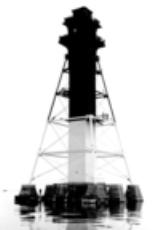
Craighill Channel Lower Range Rear Light
Encyclopedia
The Craighill Channel Lower Range Rear Light is one of a pair of range lights that marks the first section of the shipping channel into Baltimore harbor. It is the tallest lighthouse
in Maryland
.
, and new range lights were required to make it usable at night.
Initially the plan was to use screw-pile lighthouse
s (shore lights were never considered); ice in the winter of 1872-1873 led them to reconsider this, and the front light was built as a small caisson structure. For the rear light a grid of nine stone piers was laid out, and a pyramidal iron tower was erected. A central shaft of wood timbers sheathed in iron plates held the staircase to the lantern, and a wooden house surrounded this at the base of the light.
The expense of constructing foundation for the two lights exhausted the original appropriation and delayed completion until 1875; in the intervening two years lightships were used instead. The wooden construction of the central shaft had problems with rotting almost from the start, and as recently as 1994 a Coast Guard study suggested that it be removed. However, with repairs over the years it remains in place. The house was reportly rented out when the light was automated in 1923, and it was finally removed in 1938.
Lighthouse
A lighthouse is a tower, building, or other type of structure designed to emit light from a system of lamps and lenses or, in older times, from a fire, and used as an aid to navigation for maritime pilots at sea or on inland waterways....
in Maryland
Maryland
Maryland is a U.S. state located in the Mid Atlantic region of the United States, bordering Virginia, West Virginia, and the District of Columbia to its south and west; Pennsylvania to its north; and Delaware to its east...
.
History
Congress appropriated $50,000 in 1870 to enlarge the channel into Baltimore Harbor. The new channels were named after William Craighill, a lighthouse board member who supervised the surveys for the excavation. The first section of channel, starting from where Baltimore Light now stands, headed almost due north before turning into the Patapsco RiverPatapsco River
The Patapsco River is a river in central Maryland which flows into Chesapeake Bay. The river's tidal portion forms the harbor for the city of Baltimore...
, and new range lights were required to make it usable at night.
Initially the plan was to use screw-pile lighthouse
Screw-pile lighthouse
A screw-pile lighthouse is a lighthouse which stands on piles that are screwed into sandy or muddy sea or river bottoms. The first screw-pile lighthouse was built by blind Irish engineer Alexander Mitchell...
s (shore lights were never considered); ice in the winter of 1872-1873 led them to reconsider this, and the front light was built as a small caisson structure. For the rear light a grid of nine stone piers was laid out, and a pyramidal iron tower was erected. A central shaft of wood timbers sheathed in iron plates held the staircase to the lantern, and a wooden house surrounded this at the base of the light.
The expense of constructing foundation for the two lights exhausted the original appropriation and delayed completion until 1875; in the intervening two years lightships were used instead. The wooden construction of the central shaft had problems with rotting almost from the start, and as recently as 1994 a Coast Guard study suggested that it be removed. However, with repairs over the years it remains in place. The house was reportly rented out when the light was automated in 1923, and it was finally removed in 1938.
External links
- http://www.craighillrange.org
- Chesapeake Bay Lighthouse Project - Craighill Channel Range Lights

